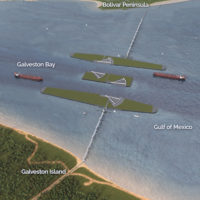A U.S. Dept. of Defense plan to begin the gravity defueling of more than 100 million gallons of jet fuel stored underground in Hawaii will go forward after state health officials issued conditional approval on June 24. The defueling and closure of the U.S. Navy-operated Red Hill Bulk Fuel Storage Facility at Joint Base Pearl Harbor-Hickam in Honolulu is on track to begin in October and conclude early next year, officials say.
The move comes after a series of major leaks from the 80-year-old tanks impacted the drinking water quality near the facility. Last year, U.S. Defense Secretary Lloyd Austin announced that the facility would be permanently closed. The Joint Task Force-Red Hill was established by the U.S. Indo-Pacific Command safely facilitate the defueling process in close coordination with the State of Hawaii.
The Defense Dept. plan, which was developed following an assessment by engineering firm Simpson Gumpertz & Heger, calls for gravity defueling to remove about 104 million gallons of fuel from 14 of the 20 tanks that comprise the massive underground facility.
The Hawaii Dept. of Health had initially rejected the plan last year, saying that the task force's effort was lacking on several points that concerned state officials. Since then, the Navy proposed eliminate the tanks from service while leaving them in the ground as well as also removing all three pipelines to ensure the tanks would not be used again.
Kathleen Ho, Hawaii’s deputy director of environmental health, said in a statement that the state’s conditional approval “is an important step forward to defuel Red Hill as quickly and safely as possible.”
“The joint task force must still complete several important steps before DOH will allow defueling to begin, and we will continue to oversee all work with safety as our top priority,” Ho said.
Red Hill Bulk Fuel Storage Facility is a 250-million-gallon-capacity fuel storage facility with 20 steel-lined, concrete storage tanks, each 250 ft tall and 100 ft in diameter with a 12.5-million-gallon capacity, built underground in cavities excavated beneath Red Hill. Three gravity-fed pipelines connect the tanks to fueling piers 2.5 miles away at Pearl Harbor. The facility was built during the 1940s, with work starting before the Dec. 7, 1941 Japanese attack on Pearl Harbor.

Miners inside one of the fuel tanks in 1942.
Photo courtesy of U.S. Army Corps of Engineers
In 2014, 27,000 gallons of fuel leaked out from one of the tanks. Following that leak, the Navy and Defense Logistics Agency stepped up modernization efforts and water monitoring under an agreement with the state. In 2021, another 19,000 gallons of fuel leaked following a pressure surge, which the EPA says impacted drinking water quality, and the U.S. Indo-Pacific Command formed the joint task force to lead the defueling.
Earlier in June, the U.S. Environmental Protection Agency finalized a consent order with the Navy and the Defense Logistics Agency earlier in the month for defueling and closure of the facility.
The Defense Dept. plan includes five phases, of which three have been completed. Additional steps include hundreds of repairs to the pipeline and other parts of the facility, which are near completion. Each repair must have its quality validated by a third party and then reviewed by the state DOH. Once the tanks are emptied, the Navy has recommended leaving the empty tanks in place, which officials say would minimize the environmental, public health, safety and other impacts.
Hawaii DOH officials also want to see operational plans for the defueling of separate surge tanks at Joint Base Pearl Harbor-Hickam, as well as for pipeline repacking, defueling of the main tanks and tank bottoms and the pipeline unpacking before defueling can begin.
Planning documents also note it is likely that between 100,000 and 400,000 gallons will remain after gravity defueling. Defense Dept. officials say they will continue to provide plan supplements to the Hawaii Dept. of Health and EPA to address the action that will be needed to ensure all the fuel is removed.
Defense Dept. records show contracts and task orders related to Red Hill have been awarded to several firms since the 2014 leak. AECOM Technical Services Inc. is providing drinking water monitoring, groundwater modeling and other environmental technical services.
Last year, Defense Dept. officials also awarded task orders to HDR Engineering Inc. for architecture-engineering services at Red Hill Water Treatment Facility; to Kiewit Infrastructure West Co. for road repairs and erosion control at the fuel storage facility and Vectrus System Corp. for operation of a 5-million-gallon-per-day granular activated carbon filtration system. A task force representative did not immediately respond to questions about additional contracting work.





Post a comment to this article
Report Abusive Comment